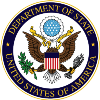#COP21: U.S. Center Exhibits On Climate Science and Action
By: Georgia Mu, Assistant Director of the U.S. Center at the UN Climate Change Conference, and Ann Hunter-Pirtle, Office of Public Affairs at the U.S. Environmental Protection Agency.
The organizers have transformed Le Bourget, best known as the hangar for the annual Paris air show, into a combination negotiation and exposition space. They expect 40,000 total attendees by the end of this week — educators, students, government officials, non-profit and private sector leaders — all committed to learning and doing more to combat climate change.
In the spirit of the event, conference organizers have gone all-in on sustainability with an extensive biodegradables and recycling program. Participants can return cutlery and reusable plastic coffee cups for a 1 Euro deposit and the cups have quickly become as good as currency. Participants have been spotted scooping up coffee cups from empty tables and desks, returning several at a time. Find enough, and you’ve got lunch covered.
The exhibit space is huge and the U.S. Center, the State Department’s public diplomacy space highlighting climate science and U.S. climate action, is one of the many pavilions where visitors can learn more during COP21.
Over the past nine days, we’ve been proud to host over three dozen events featuring U.S. government Cabinet members, U.S. and international business leaders, mayors, governors, ambassadors, ministers from several countries, scientists, and youth.
Their collective message is crystal clear: climate science is settled, and the time for action is now. Businesses know climate action is an unprecedented opportunity, but they need a strong policy signal as they make long-term investments. Many U.S. cities and states are leading on innovative climate solutions, while the federal government is taking ambitious action at home and is committed to an ambitious agreement here in Paris.
Last week at the U.S. Center, Secretary of Agriculture Tom Vilsack announced a new USDA report on the dangers posed by climate change and the advances needed in agriculture, to feed an anticipated global population of 9 billion in 2050.
We’ve heard passionate calls to action from residents who face the impacts of climate change every day. U.S. Secretary of Interior Sally Jewell hosted a conversation with Councilwoman Maija Lukin of Kotzebue, Alaska, who talked about how her village is under threat from climate change. Erosion from sea level rise threatens homes and infrastructure, while disappearing traditional food sources — like caribou, seals, and berries — leave residents vulnerable to hunger. Alson Kelen, President of the Council of NGOs of the Marshall Islands, discussed how sea level rise threatens his low-lying island country, routinely flooding streets and homes, and washing garbage and sewage through communities. Secretary Jewell also moderated a discussion with ministers from Costa Rica and Gabon who spoke about their nations’ actions to protect natural resources.
This week, NOAA Administrator and former astronaut Dr. Kathy Sullivan and White House Science Advisor Dr. John Holdren spoke about the critical need to continue to monitor the oceans and the atmosphere to understand the effects climate change is having today, and to help communities adapt.
EPA Administrator Gina McCarthy spoke passionately about the Clean Power Plan, EPA’s rule to cut carbon pollution from the power sector 32 percent below 2005 levels by 2030. She emphasized that EPA’s plan will stand the test of time because it is part of the long-standing Clean Air Act, involves extensive public engagement, and incorporates the latest science.
U.S. Energy Secretary Ernest Moniz and California Governor Jerry Brown spoke about U.S. efforts to support clean energy development and announced that the United States will host the next Clean Energy Ministerial in June of 2016 in San Francisco, California.
Beyond world-class speakers, the U.S. Center has also been home to hands on technology befitting the United State’s support of clean energy technology and climate-related innovation. NOAA’s Science on a Sphere and NASA’s Hyperwall are bringing U.S. climate science to the world, and revealing it in a way that is not just accessible, but exciting.
As we near the close of COP21, U.S. policymakers in Paris have made it clear that although American leadership on climate action is critical, no country can solve the problem alone. It will take all nations working together to protect this planet for our children and future generations.
While the negotiations are continuing, we at the U.S. Center are continuing our efforts. Watch our full lineup of events during Cop21 at www.youtube.com/theuscenter.
Editor’s Note: This blog originally appeared on DipNote, the U.S. Department of State’s Official Blog.
